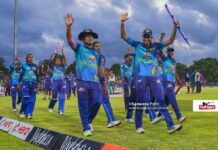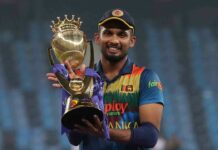Fast bowling is both an art and a science. While there are some bowlers who rely on swing and movement, others use their accuracy to make runs hard to come by, sticking to immaculate lines and lengths. And then there are those who instill fear in the batsmen with sheer, raw pace. From their cold stares to those jaw-breaking bouncers, these bowlers have sent shivers down the spine of the batsmen facing them.
Check out our list of the 11 fastest bowlers to have made an appearance at the ICC Cricket World Cup.
Andy Roberts (West Indies)
Andy Roberts is one of the greatest fast bowlers to have ever played the game. He consistently blew away sides, showing no emotion on the field. With 26 wickets from 16 matches in ICC Cricket World Cups, he is the second highest wicket-taker for West Indies in the history of the tournament.
He represented West Indies in three tournaments and ended with an incredible average of 21.23. Even though he didn’t have a single five-wicket haul to show, Roberts was a constant threat to batsmen.
Tournaments: 3 (1975, 1979, 1983)
Matches: 16
Wickets: 26
Best bowling: 3 for 32
Jeff Thomson (Australia)
Born in an era dominated by fast bowlers, Jeff Thomson ended his career with 200 Test and 55 One-Day International wickets. While his action earned him the nickname Slingin’ Thommo, his international debut didn’t prove to be fruitful. However, after coming back into the Australia squad two years later, he announced his arrival in the international arena with match figures of 9 for 105 against England. Thomson then made sure no batsman ever had it easy facing him over the next decade.
Thomson represented Australia in two ICC Cricket World Cups. However, he wasn’t able to weave his magic around the batsman and ended with just seven wickets from eight matches at an average of 41.42.
Tournaments: 2 (1975, 1983)
Matches: 8
Wickets: 7
Best bowling: 3 for 51
Joel Garner (West Indies)
In an era when West Indies boasted one of the most feared bowling attacks the sport has ever seen, none were scarier than Joel Garner. Standing at 6 feet 8 inches, Garner’s 146 wickets from 98 ODIs came at a stunning average of 18.84 and an equally impressive economy rate of 3.09.
While he didn’t play in as many matches in the ICC Cricket World Cup as some of his contemporaries, Garner still made a big impact in the tournament. With eight wickets from four matches in the 1979 edition, Garner finished as the joint leading wicket-taker for West Indies, along with Michael Holding and Colin Croft, including a match-winning 5 for 38 in the final against England that guided his team to its second ICC Cricket World Cup title.
Tournaments: 2 (1979, 1983)
Matches: 8
Wickets: 13
Best bowling: 5 for 38
Allan Donald (South Africa)
Allan Donald of South Africa was one of those bowlers who had the ability to swing the ball at great pace. Nicknamed ‘White Lightning’, Donald played in four tournaments – 1992, 1996, 1999 and 2003. As one of the greatest fast-bowlers of all time, Donald will also be remembered for his durability, making his ODI debut in 1991 before bowing out at the ICC Cricket World Cup 2003 in South Africa.
Tournaments: 4 (1992, 1996, 1999, 2003)
Matches: 25
Wickets: 38
Best bowling: 4 for 17
Waqar Younis (Pakistan)
Waqar Younis played 87 Tests and 262 ODIs during his international cricket career between 1989 and 2003. He earned the reputation of being one of the most devastating fast bowlers of all time. He is regarded as one of the best exponents of reverse swing, and used it to great effect throughout his career during which he bagged 416 ODI wickets. He was just as dangerous at the ICC Cricket World Cup, where he picked up 22 wickets from just 13 matches.
Tournaments: 3 (1996, 1999, 2003)
Matches: 13
Wickets: 22
Best bowling: 4 for 26
Shoaib Akhtar (Pakistan)
Shoaib Akhtar is one of three bowlers to have broken the 160 km/hour barrier in the history of the game, with a delivery recorded at 161.3 km/hour during the ICC Cricket World Cup 2003 against England. This remains the fastest recorded ball to date.
After he impressed in the 1999 edition, Akhtar performed poorly in the 2003 tournament and was dropped. He was then selected in Pakistan’s 15-man squad to play the World Cup in 2011, his last hurrah in international cricket.
Tournaments: 3 (1999, 2003, 2011)
Matches played: 19
Wickets: 30
Best bowling: 4 for 46
Brett Lee (Australia)
With Shane Warne withdrawn by Australia just before the start of the ICC Cricket World Cup 2003, Brett Lee formed one of the most lethal attacks of the tournament alongside Glenn McGrath and Andy Bichel. He ended the event with 22 wickets at an average of 17.90.
Lee crossed the 160 km/hour mark twice. His delivery in his first over against England in the group stage touched 160.7 km/hour, while the one in the semi-final against Sri Lanka to Marvan Atapattu reached 160.1 km/hour.
Tournaments: 1 (2003)
Matches: 10
Wickets: 22
Best bowling: 5 for 42
Shane Bond (New Zealand)
With a rhythmic run-up, smooth action and an effortless follow through, Shane Bond terrorised batsmen with his pace and swing for close to nine years. Despite a career plagued by injuries, Bond is the third highest wicket-taker for New Zealand in ICC Cricket World Cups, with only Jacob Oram and Chris Harris ahead of him.
Bond created havoc in New Zealand’s match against Australia and ended with figures of 6 for 23 in Port Elizabeth in 2003. He also played a crucial role in helping New Zealand reach the semi-final of the ICC Cricket World Cup in 2007, picking up 13 wickets from eight matches at an average of 16.38.
Tournaments: 2 (2003, 2007)
Matches: 16
Wickets: 30
Best bowling: 6 for 23
Shaun Tait (Australia)
With Brett Lee ruled out of the ICC Cricket World Cup 2007, Shaun Tait assumed the role of the spearhead. He finished the tournament as the second leading wicket-taker, along with Muttiah Muralitharan, with 23 wickets at an average of 20.30.
Tait rejoined the One-Day International squad for the 2011 edition of the tournament. He played in seven games and picked up 11 wickets before Australia lost to India in the quarter-finals. Following that defeat, Tait retired from ODI cricket.
In 2011, he also bowled a 160.7 km/hour delivery against Pakistan in a one-off T20I, the fastest ball ever bowled on Australian soil, and the third-fastest ever recorded, behind only Shoaib Akhtar and Brett Lee.
Tournaments: 2 (2007, 2011)
Matches: 18
Wickets: 34
Best bowling: 4 for 39
Mitchell Johnson (Australia)
Mitchell Johnson, who was named the International Cricket Council’s “Cricketer of the Year” in 2009, is one of the fastest modern-day pacers who regularly clocks at over 150 km/hour.
Johnson, 32, made his ODI debut against New Zealand in December 2005, and represented Australia in the ICC Cricket World Cup 2011 where he picked up 10 wickets from seven matches.
Johnson’s explosive performance against England at the Ashes has made him one of the most feared bowlers in world cricket and one to watch at the ICC Cricket World Cup 2015.
Tournaments: 1 (2011)
Matches: 7
Wickets: 10
Best bowling: 4 for 19
Dale Steyn (South Africa)
With 135 wickets from 87 ODI matches at an average of 25.62 and an economy rate of 4.82, Dale Steyn is one of the modern-day greats.
In his only appearance at the ICC Cricket World Cup – in the 2011 edition – Steyn snaffled 12 wickets from six matches at 16, including a best of 5 for 50 off 9.4 overs against India. India was on its way to a massive total but Steyn stepped in to scuttle the innings, helping South Africa inflict India’s only defeat on its way to the title.
Tournaments: 1 (2011)
Matches: 8
Wickets: 13
Best bowling: 5 for 38



























